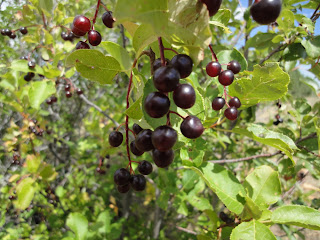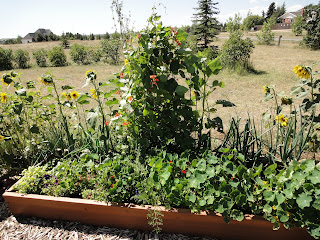How, really how, do you use up zucchini? Pick often. Pick when they are small, and you have to check the plants every day because you’ll go out to the garden one day and there will be this cute little 4” zucchini and the next day it could be as big as the Hindenburg. And you can only make so much zucchini bread…
To plant zucchini – wait till it’s warm enough at night. In Cheyenne, that’s usually the first or second week in June. At first, I planted zucchini in our raised beds, but the plants just get too big. So I plant them in the big squash, corn, bean bed (more on that later). I make three hills about 3 feet apart and plant 3 seeds in each hill. Then I thin back to one plant in a hill when they all come up. They like to be watered and will produce about as long as I keep picking.
Then come the decisions about how to use the zucchini. Do I leave them on doorsteps hoping they will have a good home? I give away nearly as much as I use, so they are a most bountiful vegetable.
I pick them when they are about 6”-8” long. When they are this size, they are sweet and crisp. I let one get to 12” this summer so I could make zucchini bread, but that was an exception.
What do we do with them?
· Slice them in rounds and put them in salads – they are nice and crunchy.
· Slice them lengthwise, then quarter them, serve with carrot sticks and dip in salad dressing.
· Slice lengthwise in half, brush with olive oil, sprinkle with a bit of salt and some dried herbs, and grill about 5 minutes on a side.
· Slice in rounds, slice an onion, mince some garlic and sauté in olive oil. Add some pesto at the end.
· Make zucchini bread or muffins or cookies.
· Make:
ROASTED GARDEN VEGGIE MARINARA
Pick some tomatoes
Zucchini
Carrots
Onions
Garlic
Peppers
Anything else you can think of
Kosher salt
Fresh ground pepper
Basil
Parsley
You want enough to load a cookie sheet with vegetables. Pour some olive oil on the baking sheet -enough to coat the pan. Cut everything up into 1”-2” pieces and put all the vegetables on the baking sheet. Drizzle some more olive oil over the veggies. Sprinkle with salt and pepper.
Put in a 325° oven and stir every 20 minutes for about an hour. Add some chopped herbs.
Your kitchen smells heavenly by this time – the garlic, the tomatoes, the roasting. You could be in Tuscany. Maybe put some Italian opera on the iPod. Then stir the veggies, not the iPod, every 10 minutes till everything is very soft. Remove from the oven and let cool a bit. Put the roasted veggies in a food processor and process till mostly smooth. I got about 4 cups from this batch.
Serve this over pasta for instant spaghetti sauce. Or put in freezer bags to use in the winter when you want some summer food. Or spread on pizza dough for a fabulous pizza topping. Kids love it and they don’t know they are eating all those different veggies. Put some fresh mozzarella on top and it’s so wonderful.
This is another recipe I found on the National Public Radio website. You can use nearly any vegetable, but it works nicely with grated zucchini. I’ve used spinach or swiss chard too.
SOUFFLE WITH VEGETABLES
Try to make sure the eggs are as fresh as possible to ensure that beautiful puffy rise in the oven. Many seasonal vegetables will work here, but try not to overwhelm the soufflé — less is more. This tastes delicious alongside wilted greens or with a big salad.
3/4 to 1 cup chopped scallions
1 cup heavy cream
1 thyme sprig
Assortment of vegetables, finely chopped
4 tablespoons unsalted butter
4 tablespoons all-purpose flour
1 1/2 cups whole milk
1 cup grated Parmesan cheese
1 teaspoon salt
1/2 teaspoon pepper
Chopped fresh herbs if you have them
4 large egg yolks
6 large egg whites
Preheat the oven to 375 degrees. Butter a 6-cup soufflé dish and dust with a sprinkling of the Parmesan cheese.
Put the garlic, cream and thyme in a small saucepan over low heat. Bring slowly to a boil, then turn off the heat, cover and let steep for 10 minutes.
For the vegetables, I use whatever I have on hand although some will work much better than others. Try a combination of finely chopped spinach and red bell pepper, or roast a butternut squash and mash it well before folding into the batter. If you're using vegetables such as garlic, mushrooms or greens, sauté in 2 tablespoons of olive oil in a frying pan over medium heat for about 5 minutes until soft, then set aside.
Melt the 4 tablespoons of butter in a saucepan and stir in the flour, whisking, over low heat. Cook for one minute while whisking slowly. Whisk in the milk and stir until it thickens. Turn off heat and stir in the Parmesan, salt, pepper, herbs, egg yolks, vegetables and cream mixture.
In another bowl, beat the egg whites with a whisk or a hand mixer until they form soft peaks. Gently, fold the whites into the base and scrape the batter into the soufflé dish. Bake until golden brown and set, about 30 minutes. Serve immediately.
I know this has lots of steps but it looks incredibly impressive when it comes out of the oven. And it’s delicious.
Or for desserts, there are these two. Again, no one has to know they are eating vegetables if you don’t want them to know it. The first one is just fabulous and, if you heat a piece in the microwave for about 15 seconds, it’s just like eating chocolate molten cake. You will soon learn that I love chocolate. We’ll do a chocolate page later, too.
CHOCOLATE, CHOCOLATE CHIP ZUCCHINI CAKE
Read more about it at www.cooks.com/rec/view/0,171,147185-225193,00.html
Content Copyright © 2011 Cooks.com - All rights reserved. 1/2 c. soft butter
1/2 c. oil
1 3/4 c. sugar
2 eggs
1 tsp. vanilla
1/2 c. sour milk
2 1/2 c. flour
4 tbsp. cocoa
1 tsp. baking soda
1/2 tsp. cinnamon
1/2 tsp. cloves
1/2 tsp. salt
2 c. grated zucchini
1/4 c. chocolate chips
1/4 c. chopped nuts
Cream butter, oil, and sugar together; add eggs, vanilla and sour milk. Blend thoroughly. Sift together flour, cocoa, soda, cinnamon, cloves, and salt. Blend with creamed mixture. Stir in zucchini. Spoon into greased and floured 9 x 13 x 2 inch pan. Sprinkle with chocolate chips and nuts. Bake in a preheated 325 degree oven 45 minutes or until done.
This next one is about as healthy as you can get – I love that it’s made with olive oil (trust me on this) and honey. Again, heat a piece in the microwave and it’s wonderful. I want some now.
DOUBLE CHOCOLATE ZUCCHINI BROWNIES
2 c. grated zucchini
½ c. olive oil
½ c. honey or agave nectar
2 eggs
1 tsp. vanilla extract
1 ¾ c. whole wheat flour
½ c. unsweetened cocoa powder
½ tsp. salt
1 ½ tsp. baking powder
½ tsp. cinnamon
1 ½ c. semi sweet chocolate chips
Preheat oven to 350°. Grease an 8x8” baking pan and line with parchment paper (I did this both times I made the brownies and it seems to work). Grease the parchment paper.
Press the zucchini with a paper towel to remove excess moisture. Fluff with a fork. In a large bowl, beat together oil, honey, eggs and vanilla. Stir in zucchini. In another bowl, sift or stir together the dry ingredients. Add dry ingredients to the zucchini mixture. Stir to combine. Add chocolate chips. Pour into prepared pan. Bake 30-40 minutes or until a toothpick inserted in the center comes out clean. Let cool completely. Remove from pan using the parchment paper. Serve chilled for a fudgy brownie or warmed for a gooey, cakey brownie.
You probably have some other zucchini recipes, but these can get you started. Enjoy!






































